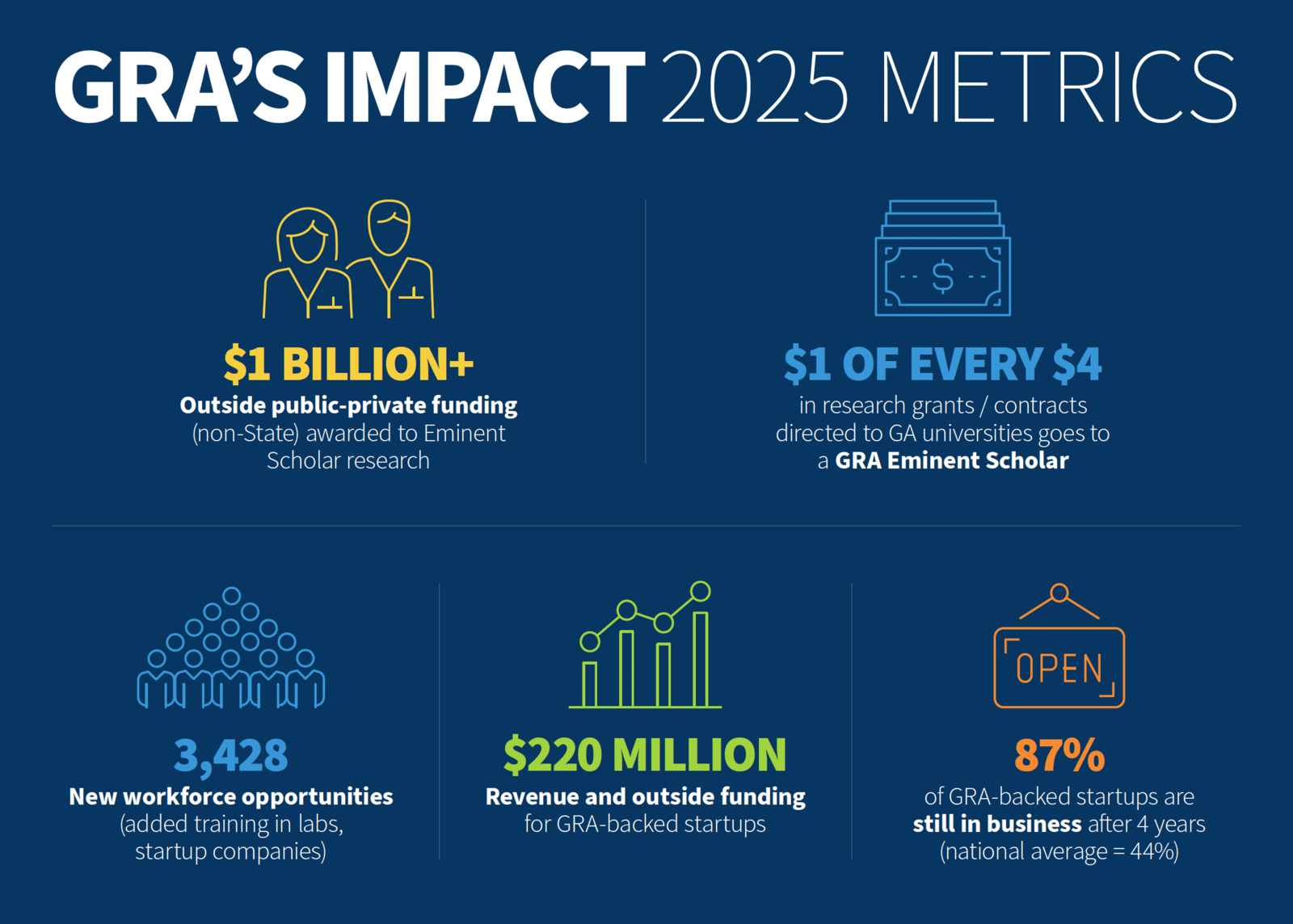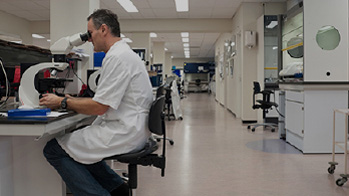Bringing discovery to life
Growing university research, entrepreneurship creates lasting impact on Georgia
The Georgia Research Alliance drives more impact out of university research and entrepreneurship to benefit our state — and the world.
Our work grows the Georgia economy, helps prepare a high-tech workforce and improves the lives of Georgians. We do this by:
- Recruiting brilliant researchers to Georgia’s universities. They form the Academy of GRA Scholars, and they typically arrive with research teams and millions of dollars in grants. While here, they attract more private and public research dollars.
- Investing smartly in sophisticated lab technologies. GRA adds equipment and updates facilities to help researchers win more grants. GRA also makes it possible for all university scientists in Georgia to share high-tech instruments.
- Turning more inventions into products. GRA provides crucial seed funding and guidance to help university researchers move promising discoveries to the marketplace. And GRA Venture Fund provides more investment and counsel to high-potential startups.
GRA’s ROI on Georgia’s investment
The State of Georgia provides GRA with funds to invest. (Private donations – gifts from people, companies and foundations – fund GRA’s operations.)
The strong return on Georgia’s investment has several dimensions:
- More money coming to Georgia. GRA’s total investment of $728 million in state dollars (since 1991) has attracted $16 billion in research grants, venture capital, matching funds and other dollars. The leveraged capital is used for multiple purposes, generating a direct return to state and local tax digests.
- New workforce opportunities created. As research expands, more positions are created in labs. As startups are launched, more jobs are created in companies. The nearly 3,500 professionals currently employed constitute a significant contribution to workforce preparation in highly skilled, high-tech areas.
- Improving the national competitiveness of our state. GRA’s activity helps fuel Georgia’s innovation ecosystem. And the results of our efforts strengthen our state’s case in recruiting new industry here.
Other forms of ROI
GRA’s impact on Georgia takes other forms:
- Discoveries that benefit Georgians. A breakthrough way to diagnose autism much sooner … software that allows a state agency to thwart healthcare fraud … technology that improves crop yields for Georgia farmers … these are just a few inventions we’ve advanced that serve people in our state and beyond. See others >
- A mechanism to get things done. Having a nonprofit like GRA gives our state’s leadership a ready-made resource to address critical issues. For example, we launched an initiative to solve sickle cell disease and landed a $20 million NSF grant to use artificial intelligence to improve online learning.
- Getting universities to work together. Georgia’s public and private universities collaborate in extraordinary ways because of GRA. Whether sharing equipment or partnering on big research projects, we’ve created a level of cooperation that is unmatched by any other state.
How we got here
GRA is a nonprofit (501c3), public-private partnership that partners with both the University System of Georgia and Georgia’s Department of Economic Development. We are also proud to be an affiliate of the Georgia Chamber working to promote a healthy business environment in our state.
Our partner universities include:
- The University of Georgia
- Augusta University
- Emory University
- Clark Atlanta University
- Georgia Institute of Technology
- Georgia State University
- Mercer University
- Morehouse School of Medicine
As for our beginnings — the story begins with a missed opportunity.
In 1983, the State of Georgia failed to win a headquarters bid for a large industry consortium seeking a place to develop the next generation of semiconductor technology.
The consortium – Microelectronics Computer and Technology Corporation – was located in Austin, Texas, where it jump-started the city’s fledgling tech industry and established a high-tech hub.
The critical factor in Austin’s “win” was a public-private partnership that combined government resources and private sector energy and creativity. Georgia quickly realized the benefits of having a privately run technology alliance that could leverage state dollars to expand university research capacity.
In 1990, a group of Georgia leaders established the nonprofit Georgia Research Alliance to help business, research universities and state government collaborate to build a technology-driven economy fueled by breakthrough university research. The late Lawrence L. Gellerstedt, Jr. – who had chaired the Georgia Research Consortium, the state’s 1980s-era attempt at a technology authority – was named chair of GRA.
The plan was to attract some of the world’s most brilliant scientists to establish new programs of research and development at affiliated Georgia research universities. The focus would be in areas with the most potential for generating new companies and creating new science and technology jobs.
The cadre of scientists, named GRA Eminent Scholars®, would:
- compete successfully for a larger share of federal and foundation research funds
- attract other talented scientists and graduate students to Georgia
- foster new companies and create relationships with industry to commercialize technologies developed through research
Today, GRA is an internationally acclaimed model for unifying business, research universities, and state government to create and sustain a vibrant, technology-rich economy for the state.
One of GRA’s most important accomplishments has been unifying the state’s research institutions to foster cross-university research, which is often critical when competing for federal research funding. Presidents of each university sit on GRA’s board, along with prominent leaders in government and industry.
Read an overview of GRA's history >
Note: GRA does not provide indirect funding for talent, equipment, and grants awarded to the universities.




